
Halebidu is a town located in Hassan District, Karnataka, India. Halebidu was the regal capital of the Hoysala Empire in the 12th century. It is home to some of the best examples of Hoysala architecture. Most notable are the ornate Hoysaleshwara and Kedareshwara temples. The city got the name "Halebidu" because it was damaged and deserted into "old capital" after being ransacked and looted twice by forces of the Delhi Sultanate in the 14th century.
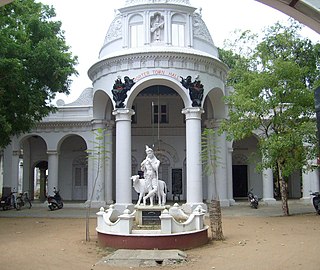
Kumbakonam is a town and a special grade municipality in the Thanjavur district in the Indian state of Tamil Nadu. It is located 40 km (25 mi) from Thanjavur and 273 km (170 mi) from Chennai and is the headquarters of the Kumbakonam taluk of Thanjavur district. The town is bounded by two rivers, the Kaveri River to the north and Arasalar River to the south. Kumbakonam is known as a "temple town" due to the prevalence of a number of temples here and is noted for its Mahamaham festival which attracts people from all over the country.

Madurai is a major city in the Indian state of Tamil Nadu. It is the cultural capital of Tamil Nadu and the administrative headquarters of Madurai District and Pandya Nadu, the third largest city in Tamil Nadu and 44th most populated city in India. Located on the banks of River Vaigai, Madurai has been a major settlement for two millennia.

Tiruchirappalli, also called Tiruchi or Trichy, is a major tier II city in the Indian state of Tamil Nadu and the administrative headquarters of Tiruchirappalli district. It is the fourth largest city as well as the fourth largest urban agglomeration in the state. Located 322 kilometres (200 mi) south of Chennai and 374 kilometres (232 mi) north of Kanyakumari, Tiruchirappalli sits almost at the geographic centre of the state. The Cauvery Delta begins 16 kilometres (9.9 mi) west of the city where the Kaveri river splits into two, forming the island of Srirangam, which is now incorporated into the Tiruchirappalli City Municipal Corporation. The city occupies an area of 167.23 square kilometres (64.57 sq mi) and had a population of 916,857 in 2011.
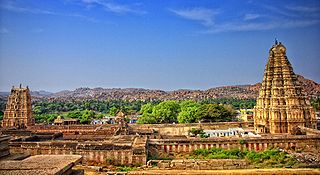
Hampi or Hampe, also referred to as the Group of Monuments at Hampi, is a UNESCO World Heritage Site located in east-central Karnataka, India. It is a pilgrimage centre of the Hindu religion.
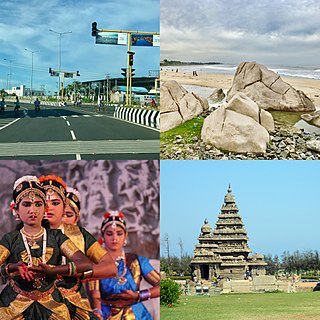
Mahabalipuram, also known as Mamallapuram, is a town in Chengalpattu district in the southeastern Indian state of Tamil Nadu, best known for the UNESCO World Heritage Site of 7th- and 8th-century Hindu Group of Monuments at Mahabalipuram.It is one of the famous tourist sites in India.

Mannargudi is a town in Tiruvarur district in the Indian state of Tamil Nadu. It is the headquarters of the Mannargudi taluk. The town is located at a distance of 20 km (12 mi) from the district headquarters Tiruvarur and 310 km (190 mi) from the state capital Chennai. Mannargudi is known for the Rajagopalaswamy temple, a prominent Vaishnavite shrine.
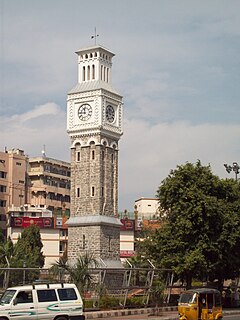
Secunderabad is the twin city of Hyderabad in the Indian state of Telangana. Named after Sikandar Jah, the third Nizam of the Asaf Jahi dynasty, Secunderabad was established in 1806 as a British cantonment. Although both the cities are together referred to as the twin cities, Hyderabad and Secunderabad have different histories and cultures, with Secunderabad having developed directly under British rule until 1948, and Hyderabad as the capital of the Nizams' princely state of Hyderabad.
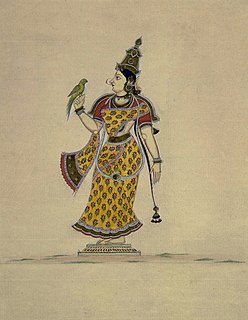
Meenakshi, is a Hindu goddess and tutelary deity of Madurai who is considered an avatar of the Goddess Parvati. She is the divine consort of Sundareswarar, a form of Shiva. She finds mention in literatures as the princess or queen of the ancient Pandya kingdom who elevates to godhood. The goddess is also extolled by Adi Shankara as Shri Vidya.

Adoni is a city in the Kurnool district in the Indian state of Andhra Pradesh. It is a municipality and the headquarters of Adoni mandal, administered under the Adoni Revenue Division. In the 2011 census of India, Adoni had a population of 166,344, making it the 16th most populous town in the state with an urban agglomeration population of 184,625.

The Vayalur Murugan Temple is a Hindu temple dedicated to Muruga, son of Lord Shiva and Parvati, located in the village of Kumaravayalur in Tiruchirapalli district, Tamil Nadu, India. The temple is believed to have been initiated during the period of Medieval Cholas during the 9th century. The temple is maintained and administered by the Hindu Religious and Charitable Endowments Department of the Government of Tamil Nadu. Though the presiding deity is Shiva, the temple is known for the Murugan shrine. The temple is associated with Hindu savant, Kirupanandha Variyar.
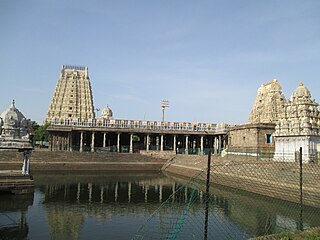
Ekambareswarar Temple is a Hindu temple dedicated to the deity Shiva, located in the town of Kanchipuram in Tamil Nadu, India. It is significant to the Hindu sect of Saivism as one of the temples associated with the five elements, the Pancha Bhoota Stalas, and specifically the element of earth, or Prithvi. Shiva is worshiped as Ekambareswarar or Ekambaranathar, and is represented by the lingam, with his idol referred to as Prithvi lingam. His consort Parvati is depicted as Elavarkuzhali. The presiding deity is revered in the 7th century Tamil Saiva canonical work, the Tevaram, written by Tamil saint poets known as the nayanars and classified as Paadal Petra Sthalam. The temple also houses Nilathingal Thundam Perumal temple, a Divyadesam, the 108 temples revered in the Vaishnava canon Nalayira Divya Prabhandam.
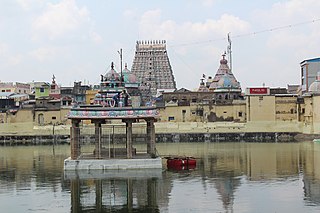
Adi Kumbeswarar Temple, Kumbakonam is a Hindu temple dedicated to the deity Shiva, located in the town of Kumbakonam in Thanjavur District Tamil Nadu, India. Shiva is worshiped as Adi Kumbeswarar, and is represented by the lingam. His consort Parvati is depicted as Mangalambigai Amman. The presiding deity is revered in the 7th century Tamil Saiva canonical work, the Tevaram, written by Tamil saint poets known as the Nayanmars and classified as Paadal Petra Sthalam.

Airavatesvara Temple is a Hindu temple of Dravidian architecture located in the town of Darasuram, near Kumbakonam, Thanjavur District in the South Indian state of Tamil Nadu. This temple, built by Rajaraja Chola II in the 12th century CE is a UNESCO World Heritage Site, along with the Brihadeeswara Temple at Thanjavur, the Gangaikondacholisvaram Temple at Gangaikonda Cholapuram that are referred to as the Great Living Chola Temples.

Arunachalesvara Temple, is a Hindu temple dedicated to the deity Shiva, located at the base of Arunachala hill in the town of Thiruvannamalai in Tamil Nadu, India. It is significant to the Hindu sect of Saivism as one of the temples associated with the five elements, the Pancha Bhoota Stalas, and specifically the element of fire, or Agni.
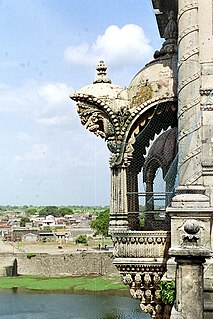
The Naulakha Palace, the oldest extant palace in Gondal, India, dating back to the 18th century (1748), with a "sculpted facade" is a part of the Darbargardh fort complex. It is named "Navalakaha" meaning rupees "nine lakhs" which was the cost of building it at that time. It has stone carvings with "jharokhas" (balconies), a pillared courtyard, delicately carved arches, and a unique spiral staircase. The large chandelier-lit "durbar" hall witnesses stuffed panthers, gilt wooden furniture, and antique mirrors. The "private palace museum" displays an array of silver caskets which were in the services of carrying messages and gifts for the Maharajah Bhagwat Sinhji on his silver jubilee as ruler of Gondal.

The Thayumanavar Temple is a temple situated in the Rockfort complex in the city of Tiruchirappalli, India. The temple is situated close to the base of the Rockfort and was constructed by the Pallava king Mahendravarman I in the 6th century AD. Shiva is worshiped as Thayumanavar, and is represented by the lingam and his consort Parvati is depicted as Mattuvar Kuzhalammai. The presiding deity is revered in the 7th century Tamil Saiva canonical work, the Tevaram, written by Tamil saint poets known as the nayanars and classified as Paadal Petra Sthalam.
Christ Church is the oldest English church in the town of Tiruchirappalli. It is situated to the north of the famous Teppakulam tank.

Tiruchirappalli Fort is a dilapidated fort in India which once protected the Old City of Trichy encompassing Big Bazaar Street, Singarathope, Bishop Heber School, Teppakulam and Tiruchirapalli Rock Fort. All that remains now is a railway station with that name and Main Guard Gate along West Boulevard Road in the city of Tiruchirappalli in Tamil Nadu. The fort can be traced along West Boulevard Road in West, East Boulevard Road in East, Butter-worth Road in North and Gandhi Market to the South.
Sivaganga Palace is a palace in Sivaganga district, Tamil Nadu, southern India, about 40 kilometres (25 mi) from Madurai. It is an old royal palace, with many historical connections. The palace was used as residence by queens Velu Nachiyar (1780–90), Vellacci Nachiyar (1790–93) and Rani Kaathama Nachiar (1864–77). No remains of the original Sivaganga Palace exist, but a new palace, known as "Gowri Vilasam", was built by Padamathur Gowry Vallabha Thevar (1801-1829) in the year 19th century. A heritage site of Chettinad, it was the property of Rani Velu Nachiar.

















